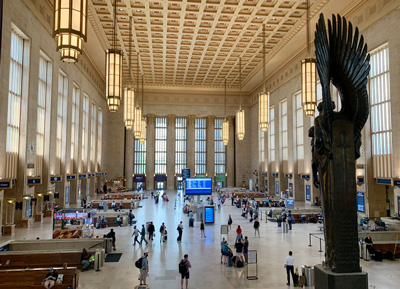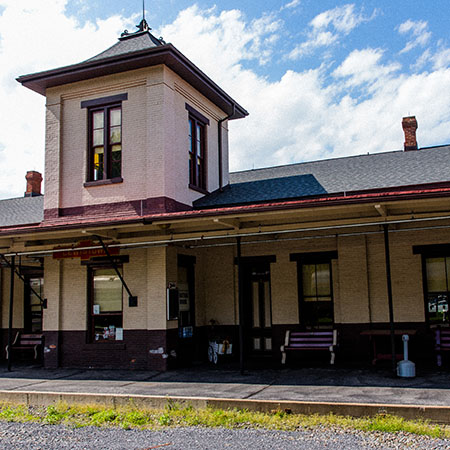Approximately one-third of the more than 500 stations served by Amtrak are listed on the National Register of Historic Places, either individually or as contributing structures to historic districts. Many of these same stations are also listed on state and local historic registers.
Historic designation can be a powerful tool for a community contemplating the renovation or adaptive reuse of a station. Historic designation—and whether it takes place at the federal, state or local level—determines:
- Eligibility for tax benefits
- The ability to delay or stop demolition orders
- The type of renovation or restoration work allowed
Properties placed on the National Register of Historic Places (NRHP) enjoy many advantages, such as:
- Increased public awareness and recognition
- Access to International Building Code fire and life safety code alternatives
- Acknowledgement of the listing with a bronze plaque designating it as part of the National Register of Historic Places
Station owners can use the NRHP affiliation to create new opportunities to network and learn from other listed properties on the care and maintenance of their historic structures.
The National Register is purely honorific and in no way restricts a property owner’s use of the property; station owners have the right to refuse listing. Local designation is generally accompanied by more stringent legal tools that can be used to delay demolition.
Tax Benefits
Station owners that are not tax-exempt are also able to take advantage of generous tax credits and funding opportunities. Tax-exempt entities can become involved in rehabilitation projects eligible for historic preservation tax credits by forming a limited partnership and maintaining a minority ownership interest as a general partner. Although the tax-exempt entity would not be entitled to any tax credits, the partnership allows it to see that larger organizational and community planning goals are met.

Gray 30th Street Station in Philadelphia is historically designated at national, state and local levels. The Pennsylvania Railroad War Memorial sculpture in the foreground is also a city historic landmark.
It is important to note that in order to claim federal historic preservation tax credits, the owner must ensure that the rehabilitated station includes income-producing commercial or industrial uses. Many states also offer historic preservation tax credits.
If a station owner chooses to take advantage of federal historic preservation tax credits, then work must be in accordance with the Secretary of the Interior’s Standards for the Treatment of Historic Properties, which may affect the massing and scale of additions as well as the range of materials and construction methods used for rehabilitation or new construction. Using federal funds also requires a Section 106 Review that may add time to the overall project and subject it to more rigorous design oversight.
Read Protecting and Promoting Rail Stations Through Historic Designation Programs for further information about the benefits of historic designation for your station.
Did You Know?
The oldest depots in the Amtrak network include:
- Lewistown, Pa. (1849)
- Castleton, Vt. (c. 1850), located in the Castleton Village National Historic District
- Ferrisburgh-Vergennes, Vt. (c. 1851)
- Jefferson City, Mo. (1855), located in the Missouri State Capitol Historic District
Three stations are also considered National Historic Landmarks, which according to the National Park Service, “…are nationally significant historic places…[that] possess exceptional value or quality in illustrating or interpreting the heritage of the United States.” These stations, which are all individually listed on the National Register, include:
- Harrisburg, Pa. (1887)
- Richmond, Va. – Main Street Station (1901)
- Cincinnati, Ohio – Union Terminal (1933)
Glance through a complete list of Amtrak-served stations located on the National Register of Historic Places.



 Amtrak established the Great American Stations Project in 2006 to educate communities on the benefits of redeveloping train stations, offer tools to community leaders to preserve their stations, and provide the appropriate Amtrak resources.
Amtrak established the Great American Stations Project in 2006 to educate communities on the benefits of redeveloping train stations, offer tools to community leaders to preserve their stations, and provide the appropriate Amtrak resources. Amtrak is seizing a once-in-a-lifetime opportunity to transform rail and Retrain Travel. By modernizing, enhancing and expanding trains, stations and infrastructure, Amtrak is meeting the rising demand for train travel. Amtrak offers unforgettable experiences to more than 500 destinations across 46 states and parts of Canada. Learn more at
Amtrak is seizing a once-in-a-lifetime opportunity to transform rail and Retrain Travel. By modernizing, enhancing and expanding trains, stations and infrastructure, Amtrak is meeting the rising demand for train travel. Amtrak offers unforgettable experiences to more than 500 destinations across 46 states and parts of Canada. Learn more at